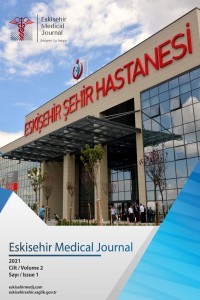Pediatrik Hidrosefali Olgularında Şant Revizyonlarının Değerlendirilmesi
Hidrosefali, Komplikasyon, Meningomyelosel, Ventriküloperitoneal Şant
Evaluation of Shunt Revisions in Pediatric Hydrocephalus Cases
Hydrocephalus, Complications, Meningomyelocele, Ventriculoperitoneal Shunt,
___
- 1. Broggi M, Zattra CM, Schiariti M, Acerbi F, Tringali G, Falco J, Valentini LG, Farago G, Ferroli P, Broggi G: Diagnosis of Ventriculoperitoneal Shunt Malfunction: A Practical Algorithm. World Neurosurg. 137:e479–86, 2020
- 2. Browd SR, Gottfried ON, Ragel BT, Kestle JRW: Failure of cerebrospinal fluid shunts: Part II: Overdrainage, loculation, and abdominal complications. Pediatr Neurol. 34(3):171–6, 2006
- 3. Caldarelli M, Di Rocco C, La Marca F: Shunt complications in the first postoperative year in children with meningomyelocele. Child’s Nerv Syst. 12(12):748–54, 1996
- 4. Drake JM, Kestle JRW, Tuli S: CSF shunts 50 years on - Past, present and future. Child’s Nerv Syst. 16(10–11):800–4, 2000
- 5. Eroğlu A, Eseoğlu M, Yalçin E, Atabey C: Evaluation of Shunt-related Complications in Ventriculoperitoneal Shunt Performed with a Hydrocephalus Diagnosis of 47 Cases. Türk Nöroşir Derg. 26(1):36–9, 2016
- 6. Ghritlaharey RK, Budhwani KS, Shrivastava DK, Srivastava J: Ventriculoperitoneal shunt complications needing shunt revision in children: A review of 5 years of experience with 48 revisions. African J Paediatr Surg. 9(1):32–9, 2012
- 7. Kahle KT, Kulkarni A V., Limbrick DD, Warf BC: Hydrocephalus in children. Lancet 387(10020):788–99, 2016
- 8. Madsen JR, Boyle TP, Neuman MI, Park EH, Tamber MS, Hickey RW, Heuer GG, Zorc JJ, Leonard JR, Leonard JC, Keating R, Chamberline JM, Frim DM, Zakrzewski P, Klinge P, Merck LH, Piatt J, Bennett JE, Sandberg DI, Boop FA, Hameed MQ: Diagnostic accuracy of non-invasive thermal evaluation of ventriculoperitoneal shunt flow in shunt malfunction: A prospective, multi-site, operator-blinded study. Neurosurgery 87(5):939–48, 2020
- 9. Morina Q, Kelmendi F, Morina A, Morina D, Bunjaku D: Ventriculoperitoneal shunt complications in a developing country: a single institution experience. Med Arh. 67(1):36–8, 2013
- 10. Morissette I, Gourdeau M, Francoeur J: CSF Shunt Infections: A Fifteen-Year Experience with Emphasis on Management and Outcome. Can J Neurol Sci. 20(2):118–22, 1993
- 11. Notarianni C, Vannemreddy P, Caldito G, Bollam P, Wylen E, Willis B, Nanda A: Congenital hydrocephalus and ventriculoperitoneal shunts: Influence of etiology and programmable shunts on revisions. J Neurosurg Pediatr. 4(6):547–52, 2009
- 12. Shannon CN, Acakpo-Satchivi L, Kirby RS, Franklin FA, Wellons JC: Ventriculoperitoneal shunt failure: An institutional review of 2-year survival rates. Child’s Nerv Syst. 28(12):2093–9, 2012
- 13. Tamber MS, Klimo P, Mazzola CA, Flannery AM: Pediatric hydrocephalus: Systematic literature review and evidence-based guidelines. Part 8: Management of cerebrospinal fluid shunt infection. J Neurosurg Pediatr. 14(November):60–71, 2014
- 14. Tervonen J, Leinonen V, Jääskeläinen JE, Koponen S, Huttunen TJ: Rate and Risk Factors for Shunt Revision in Pediatric Patients with Hydrocephalus—A Population-Based Study. World Neurosurg. 101:615–22, 2017
- ISSN: 2718-0948
- Yayın Aralığı: Yılda 3 Sayı
- Başlangıç: 2020
- Yayıncı: Eskişehir Şehir Hastanesi
Yan Ağrısı ile Nadir Bir Başvuru Nedeni: Retroperitoneal Fibrozis
Gülşah UÇAN, Mustafa Emin ÇANAKÇI, Ömer Erdem ŞEVİK, Ruhi CÜRE, Ata ÖZEN
Murat DUYAN, İbrahim Ulaş ÖZTURAN, Mustafa Ayhan OZBEK, Hüseyin SEVIL, Ökkeş ZORTUK, Resmiye Nur OKUDAN, Fatih SELVİ, Aslıhan Yürüktümen ÜNAL, Yıldıray ÇETE
Hasan İNAL, Zeynep OZTURK INAL, İlknur KÜÇÜKOSMANOĞLU, Meryem İlkay EREN KARANİS
Pediatrik Hidrosefali Olgularında Şant Revizyonlarının Değerlendirilmesi
Adem KURTULUŞ, Ayhan TEKİNER, Halil KUL, Yavuz ERDEM, Haydar ÇELİK, Mehmet Emre YILDIRIM, Mehmet Akif BAYAR
Akut konjestif kalp yetmezliğine neden olan dev sol atriyum: bir olgu sunumu
Murat DUYAN, Serhat GÜNLÜ, Ali SARIDAŞ, Resmiye Nur OKUDAN, İbrahim Ulaş ÖZTURAN
Streptococcus porcinus Endokarditi: İnsanlarda Bildirilen İlk Olgu
Nur CANCAN GÜRSUL, Emre ÖZDEMİR
Aysun TÜRE, Nilüfer DEMİRSOY, Özge GÖDEK
İrfan GÖKÇEK, Bedriye Müge SÖNMEZ, Çiğdem YÜCEL, Mebrure Beyza GÖKÇEK, Fatih Alper AYYILDIZ
